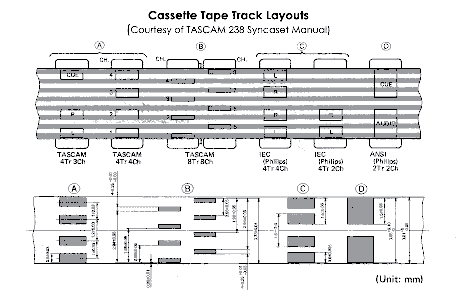 0.15 incg (3.81 mm) wide tape is best known today for its use in the audio cassette, but it also has other uses. This is the narrowest audio tape in common use.
0.15 incg (3.81 mm) wide tape is best known today for its use in the audio cassette, but it also has other uses. This is the narrowest audio tape in common use.
In most applications, this tape runs at 1-7/8 inches (47.625 mm) per second (although a few run one or two speeds slower or one speed faster).
Bill Wray found an interesting format, the DC-International Format on the same width tape, 1/2-track mono recording, but the speed was 2 inches (50.8 cm) per second.
The image at the right shows most (but not all) of the track formats that are recorded on 0.15″ tape. Click on it to open a full-sized copy in a new window.
In this view, tape moves from left to right, with the deck plate at the bottom of the picture. This view is of the tape magnetic coating surface and the heads are either reflected or the view is through the heads. Cassettes are B-wind, with the oxide away from the hub. Unlike reel tapes, where the track numbering starts away from the deck plate, cassette numbering starts at the deck plate.
Since the tape is usually mounted in a molded plastic shell, critical alignment is a major issue in acheiving the highest-quality reproduction of the tape. Individual restorers approach this differently. Some, including the author of these Web pages, uses Nakamichi Dragons which adjust the play head azimuth automatically to match the azimuth at which the recording was made.
Please note that this tape is 0.150″ which is closer to 1/7″ than 1/8″. Calling it 1/8″ is confusing, I think. It is slightly narrower than 4 mm (DAT tape).
See also: equalization, noise reduction, reels & hubs, speeds, synchronization, tape timing, tape winding, and track configurations.
Standard mono and stereo cassettes (the two right hand track configurations in the above diagram) are the most common. These can easily be reshelled if there are problems with the shell. Sticking and squealing and broken tapes can also be repaired. These normally run at 1-7/8 in/s but some recorders also were able to record at 15/16 in/s.
Microcassettes are used widely in dictation and interviews. They run at 15/16 or 15/32 in/s (slower than standard cassettes) and also run backwards as compared with the standard cassette. We acheive excellent results in re-shelling these tapes and transferring them in our Nakamichi Dragons which are far superior reproducers than any ever built for microcassettes. There are special forensic transfer devices and we can acheive many of the same results using our 4- and 8-track cassette machines.
4- and 8-track “standard” cassettes were used by musicians for recording on Porta-Studio(tm)-type devices. These typically run at 3.75 in/s (faster than standard cassettes). There were also voice-recording systems that were typically 4-tracks and ran at 15/16 in/s. We have the high-end Tascam standalone units to handle these formats and have successfully transferred 15/16 in/s voice tapes with surprising fidelity.
Revere Cartridges were developed by 3M and CBS Labs in the 1960s. These were single-hub cartridges (as opposed to the two-hub cassettes) that used 0.150 tape (with a wider leader) and were designed for up to 3-track recording. Fortunately, the third track was never implemented, so these can be transferred on the 4-track Tascam unit with good results. We load the tape into standard cassette shells.
Nagra SN reel tapes are 0.150″ wide and can be loaded into standard cassette shells for reproduction, but using an SN if one were available would be preferred. It is interesting to note that recently some reel-to-reel tape machines that are supposed to look “cool” have been marketed under the RCA name. These appear to be using 0.150″ tape.
Stuzzi Memocord cassettes were a rim-drive cassette with all the inherint speed variations one would expect from that type of drive. Rim drive (no capstan) is discussed on the tips page. We successfully transferred one as part of our first restoration seminar for archivists in November 2005.